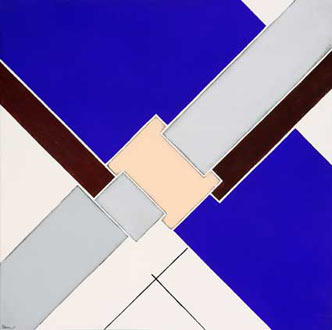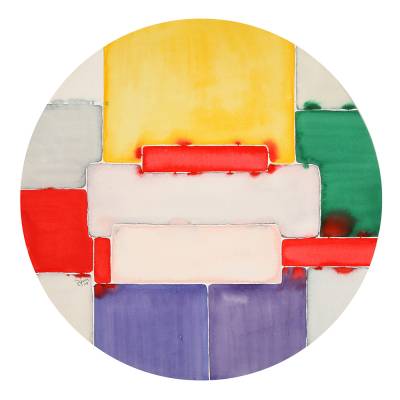„Schachtelphasen / Box Phases“ 1967 – 1968
While in the "stain" and "stripe images" the expressive power of colors was in the foreground, Rolf Hans now gives in the subsequent creative phase from 1967 to 1970, the visual appearance of the colors more weight. Now, in line with Josef Alber's geometric abstraction, he emphasizes the inherent laws of color. His attention is primarily on their spatial effect, which is constantly changing due to the juxtaposition or the interaction of the sounds. At first, Hans explores this change in the "box paintings": horizontal and vertical rectangles, strips and beams no longer meet in them as they line up next to each other or collide, but overlap. In addition, the 'distance value' of their color enhances the mesh-like compositional structure. However, the resulting pushing back and forth of the color fields is mitigated by narrow dividing lines - usually the white of the painting ground - so that their action takes place within a plane and at the same time this is bound to the picture surface.
In particular, the watercolors receive a further dynamic moment through the inner life of the color surfaces. As in „Gelb-Violett- Rot - Grün“, 1968, this is achieved by means of the different painting style. Thus, the water color is sometimes irregular, evenly opaque or transparent applied, the colors of individual areas partially overlap in adjacent fields. In addition, the round picture format of the sheet gives the composition a further boost of movement.
Not only the effect of the round format proves Hans, but also the rhombus. For the majority of his "box paintings", however, he chooses the square where he often arranges the design direction diagonally. This also applies to the acrylic painting „Blau-Braun", 1968, in which also the quality of the individual fields differ. Thus, the colors are applied either evenly to the boundaries evenly opaque, or they are applied in layers, whereby the lower layer is visible at the edges. This edging gives the composition an exciting vibrancy in addition to color contrast and diagonal alignment.
In order to create clarity in the design of these works on the effect of colors, shapes, lines and surfaces, Hans prepares paper collages, which serve him not only to control, but also to analyze his compositional ideas: "This work with precut or easy changeable forms, with this variety of colors, carries on. Looking back, I have to say that getting ahead with my own work always went beyond the collages. Due to its variability and interchangeability before being fixed with glue, it allows every attempt at composing. [...] "
 Blau-Braun, 1968
Blau-Braun, 1968
